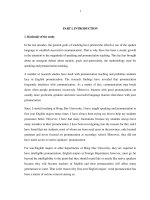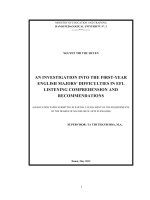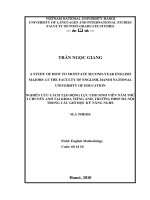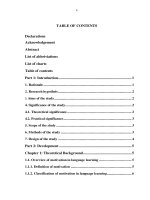Using software to improve first year english majors pronunciation
Bạn đang xem bản rút gọn của tài liệu. Xem và tải ngay bản đầy đủ của tài liệu tại đây (22.47 MB, 55 trang )
VIETNAM NATIONAL UNIVERSITY, HANOI
UNIVERSITY OF LANGUAGES AND INTERNATIONAL STUDIES
FACULTY OF POST-GRADUATE STUDIES
TRINH T H I HANG
USING SOFTWARE TO IMPROVE FIRST-YEAR
ENGLISH MAJORS' PRONUNCIATION: AN ACTION
RESEARCH AT HONG DUC UNIVERSITY
SU DUNG PHAN MEM PHAT TRIEN KHA NANG PHAT
AM CHO SINH VIEN CHUYEN NGANH TIENG ANH NAM
THU N H A T : NGHIEN CUU HANH DONG TAI TRUONG
DAI HOC HONG DUC
M.A. Minor Program Thesis
Major: English Language Teaching Methodology
Code: 60 14 10
Supervisor: Do Tuan Minh, PhD
HANOI-2010
IV
TABLE OF CONTENT
Page
DECLARATION
i
ACKNOWLEDGEMENT
ii
ABSTRACT
iii
TABLE OF CONTENT
iv
LIST OF ABBREVIATIONS
vii
LIST OF DIAGRAMS, CHARTS, AND TABLES
^"'
PARTI. INTRODUCTION
I
1. Rationale of the study
1
2. Purposes of the study
2
3. Research questions
2
4. Scope of the study
3
5. Method of the study
3
6. Significance of the study
,
3
7. Design of the study
3
PART II. DEVELOPMENT
5
CHAPTER 1. LITERATURE REVIEW
,
5
1.1. Role of pronunciation in language learning
5
1.2. Aspects of pronunciation teaching
6
1.2.1. Vowel sounds
7
1.2.2. Consonant sounds
8
1.2.3. Word stress
9
1.2.4. Sentence stress
9
1.2.5. Rhythm
,
1.2.6. Intonation
10
,
1.2.7. Other aspects of connected speech
10
11
1.3. Approaches to pronunciation teaching
11
1.3.1. Explicit or Implicit
H
1.3.2. Top-down or Bottom-up
13
1.4. Computers-assisted language learning (CALL) and EFL learning and
teaching
14
1.5. Roles of CALL software in EFL teaching and learning
15
1.6. Benefits of using CALL softAvarc in EFL teaching and learning
16
1.7. Limitations of CALL software in EFL learning and teaching
17
CHAPTER 2. M E T H O D O L O G Y . .
19
:
2.1. Context of the study
19
2.2. Arguments for the use of an action research
19
2.3. Description of the software program
20
2.4. Subjects of the study
21
2.5. Instruments
21
2.6. Procedure
22
CHAPTER 3. DATA ANALYSIS, FINDINGS AND DISCUSSION
23
3.1. Findings from the pretest
23
3.1.1. English sounds
23
3.1.2. Stress
24
3.1.3. Rhythm and thought groups
26
3.1.4. Intonation
26
3.1.5. Linking
28
VI
3.2. The intervention
28
3.3. Findings from the post-test
30
3.3.1. English sounds
30
3.3.2. Stress
32
3.3.3. Rhythm and thought groups
ii
3.3.4. Intonation
34
3.3.5. Linldng
35
3.4. Further
findings
from
the teacher's obser>ation
and
informal
intei-view with students
37
PART HI. CONCLUSION
39
1. vSummary
39
2. Pedagogical implication
39
3. Limitations of the study
40
4. Suggestions for further research
40
REFERENCES
42
APPENDICES
I
VII
LIST OF ABBREVIATIONS
EFL:
English as a Foreign Language
NS:
Native speaker
NNS:
NOP native speaker
IT:
Information technology
CALL:
Computer-assisted language learning
CMC:
Computer mediated communication
Vlll
LIST OF DIAGRAMS, CHARTS, AND TABLES
Diagram
Diagram!
English vowels
7
Table I
English consonants
8
Table 2
Students' common mistakes in producing English sounds
24
Table 3
Students' stress on important words
24
Table 4
Students' stress on corrective words
25
Table 5
Students' intonation of statements, yes-no questions, wh-questions,
Tables
requests and suggestions
27
Table 6
Students' intonation of lists
27
Table 7
Students' performance of linking
28
Tabic 8
Aspects of pronunciation to be integrated in speaking lessons
29
Table 9
Comparison of the students' pronunciation of English sounds in the
pretest and posttest
30
Table 10
Students' stress on important words
32
Table I 1
Students' stress on corrective words
32
Table 12
Students' intonation of statements, yes-no questions, wh-questions,
polite requests and suggestions
34
Table 13
Students' intonation of lists
35
Table 14
Students' performance of linking
35
Chart I
Rhythm and thought groups
26
Chart 2
Rhythm and thought groups
33
Charts
PART I. INTRODUCTION
1. Rationale of the study
In the last decades, the general goals of teaching have primed the effective use of the spoken
language to establish successful communication. That is why there has been a steady growth
in the attention to the magnitude of speaking and pronunciation teaching. This fact has brought
about an emergent debate about models, goals and particularly, the methodology used for
speaking and pronunciation teaching.
A number of research studies have dealt with pronunciation teaching and problems students
face in English pronunciation.
The research findings have revealed that pronunciation
frequently interferes with communication. As a matter of fact, communication may break
down when people pronounce incorrectly. Moreover, learners with good pronunciation are
usually more proficient speakers and more successful language learners than those with poor
pronunciation.
Since I started teaching at Hong Due University, I have taught speaking and pronunciation to
first-year 1-nglish majors many times. 1 have always been trying my best to help my students
pronounce better. However, I have had many frustrations because my students always have
many mistakes in their pronunciation. 1 have been investigating into the reasons for this, and I
have found that my students, most of whom are from rural areas in the province, only learned
grammar and never focused on pronunciation at secondary school. Moreover, they did not
have much access to native speakers' pronunciation.
lor non-English majors at other departments of Hong Due University, they are required to
have intelligible pronunciation. English majors at Foreign Department, however, must go tar
beyond the intelligibility to the point that they should sound like or nearly like native speakers
because they will become teachers of English and their pronunciation will affect man\
generations to come. That is the reason why frst-year English majors' weak pronunciation has
been a matter of serious concern amonc us.
Due to the importance of pronunciation in language learning and the poor pronunciation of
first-year English majors at Hong Due university, I decided to introduce some changes into my
speaking and pronunciation course for first-year English majors with the hope to improve their
pronunciation. That v/as the reason why I conducted this study "Using software to improve
first-year English majors' pronunciation: An action research at Hong Due University \ which
tried to exploit the software programs available in my speaking and pronunciation lessons with
an aim to improve first-year English majors' pronunciation.
2. Purposes of the study
The purpose of this study is to improve English pronunciation for first-year English majors at
I long Due University. Specifically, it has three purposes as follows:
- To identify students' most common mistakes in their English pronunciation.
- To exploit the software program, namely Pronunciation Power as an intervention in
pronunciation lessons to improve students' pronunciation.
- To justify Ihc effectiveness of using pronunciation software in teaching r:nglish
pronunciation to first-year English majors.
3. Research questions
Regarding the importance of pronunciation teaching, purpose of the research and statement of
the problem, this study is accomplished to find the answer to the question ^How effectively is
software exploited to improve first-year English majors* pronunciation at Hong Due
university? *. Specifically, the study addressed the following three research questions:
• What are the students' most common problems regarding their English pronunciation?
• Is Pronunciation A;MCTeffective in teaching first-year English majors' pronunciation?
• If yes, how effective is it?
4. Scope of the study
The study concentrates on improving first-year English majors at Hong Due University by
using the pronunciation software named Pronunciation Power, Within its scope, the research
was aimed at justifying the effectiveness of using this software program in teaching English
pronunciation to first-year English majors at Hong Due university.
5. Methods of the study
This study is conducted as an action research because it is aimed at improving first-year
English majors' pronunciation. In order to get data, a combination of different instruments,
namely class observation, informal interviews and audio-recording, is used. The data collected
from the observation and interviews will be analyzed by qualitative method, and the data
collected through the tape scripts will be analyzed by quantitative method.
6. Significance of the study
Even though there have been numerous studies on pronunciation teaching, few investigations
into the use of software in teaching pronunciation are conducted. This research provides an
insight into the effectiveness of applying pronunciation software to the teaching of
pronunciation to first-year English majors. The results of the study will, therefore, be much
beneficial to both teachers who are considering whether to exploit software programs in their
English pronunciation lessons and students who are interested in using software programs to
improve their English pronunciation.
7. Design of the study
The study consists of three main parts as follows.
The first part deals with rationale, purposes, research questions, scope, methods and design of
the study.
The second part contains three chapters, in which chapter I reviews the literature focusing on
the theoretical basis related to teaching pronunciation and using C A L L programs in language
learning and teaching, chapter 2 presents a detailed description of the research methodology,
and chapter 3 discusses the findings of the study.
The final part summarizes all the main ideas expressed throughout the research, provides
pedagogical implications and suggests further research orientations.
According to Murphy (1991), given that most courses emphasize general oral communication
over pronunciation, teachers must seek creative ways to integrate pronunciation into speakingoriented classes in a manner clearly related to the oral communication goals of the course. He
also adds that
pronunciation
instruction
needs' to be integrated
with
broader
level
communicative activities in which speakers and listeners engage in meaning communication.
It is obvious in my situation as a teacher of English that students' weak pronunciation has
negative effect on their ability to express themselves and their ability to listen to others,
especially to native speakers. Speakers with wrong pronunciation find it difficult to make
themselves understood by the teacher and other students, which makes them embarrassed and
hesitant to continue speaking. Moreover, when a learner has already stuck to the wrong way of
pronouncing a particular word, phrase or sentence, (s)he is unlikely to recognize the authentic
pronunciation by a native speaker and fail to interpret what the speaker means.
Therefore, it can be concluded that pronunciation play an essential role in learning a foreign
language because it is intelligible pronunciation that make communication possible and even if
a speaker uses the right words with the right structure hut without correct or inlclligibic
pronunciation, s(he) is likely to cause misunderstanding, communication interruption, or even
communication breakdown.
1.2. Aspects of pronunciation teaching
As regards what teaching pronunciation involves, Ur (1996:47) claims that "the concept oj
''pronunciation
" may be said to include:
- the sounds of the language, or phonology,
- stress and rhythm
- intonation. "
Martin Hcwings in his book Pronunciation
Practice Activities
presents that the following
elements should be included in the English pronunciation teaching:
-
Segmental features with more focus on consonants, consonant clusters and vowel length
-
Suprasegmental features consisting of word stress, tonic words, weak and strong forms,
connected speech and tone, (pp.15 - 16)
1.2.1. Vowel sounds
Celce-Murcia, M., Brinton, D., and Goodwn, J, (1996) defines vowels as ""sounds in which
there is continual vibration of the vocal cords and the air stream is allowed to escape from the
mouth in an obstructed manner, without any interruption.'"
According to Roach (1998), vowels are "'sounds in the production of which there is no
obstruction to the flow of air as it passes the larynx to the lips.'' Vowels can be classified in
terms of:
- the height of the bulk of the tongue in the mouth.
- the front/back position of the tongue in the mouth.- the degree of lip-rounding.
- the length of vowels.
The classification can be shown in the following diagram:
tftilit^l
ã
\
i:
ã
ã
ã
l
i
u
j
\
\
ã a .
e
ã
\
lifLl
--rrn
3 ,
',
ã
clofô
D
ã
ã "
1
I'
1
u:
•
^
•
a:
1
Diagram 1. English vowels
8
1.2.2. Consonant sounds
According to Kelly. G, (2003:24), "'consonants are formed
by interrupting, restricting or
diverting the airflow in a variety of ways.'"
Roach (1998) define consonants as ""sounds in which there is obstruction to thejlow of air as
it passes the larynx to the lips. "
Consonants are classified according to:
- the manner of articulation
- the place of articulation
- the force of articulation
The classification of English consonants can be shown in the following tabic:
Table /. English consonants
1
Bilabial
;s
•-•
Manner or An icu
1
L
\
I'lacL' of Articulalion
Alveolar
Labio
Imor
dental
dental
.Alveo-
Palatal
Vi-h.r
Gioital
k J]
V
palatal
. ,
Stop
P
b
f
hficalivc
V
e
d
[
d
S
2
AtTnnitc
m
Niis;il
^
tJ
h
3
rfsl
n
lateral
D
j
•!p?^l
Ap]iro\iinnnt
RelroHcx
.:;*^s':
!
Approxiiniinl
\
_
Glide
S\
w
j
i
Siflfe o r i h r ( ; i o t t i s
Iv.JlCClCSS
i Voiced
•
1.2.3. Word stress
Avery and Ehrlich's (1992) state that word stress involves making vowels longer and louder.
Randolph Quirk and Sidney Greenbaun (1973:450) defines stress as the prominence with
which one part of a word or of a longer utterance is distinguished from other parts. According
to Pennington, stress has at least three prosodic features, which are duration (or length),
intensity (or loudness) and pitch (or fundamental frequency).
Word stress is closely related to intelligibility because when a word is said with incorrect
stress pattern, the listener may spend time searching for the word in the wrong stress category.
A stress pattern mistake can, therefore, cause a great deal of confusion. That is the reason why
Kelly (2000) emphasizes that it would be practical to base our teaching principle on a twolevel division (stressed or unstressed).
1.2.4. Sentence stress
According to Avery and Ehrlich (1992), in a particular sentence, one content word receives
greater stress than all others, which is referred as the major sentence stress. In most cases, the
major sentence stress falls on the last content word within a sentence. However, there are also
cases in which the major sentence stress will not fall on the final content word of the sentence.
It depends on the speakers who decide which word in their speech they want to give more or
less prominence. A word may be given less weight because it has been said already, or it may
be given more weight because the speaker want to highlight it.
The use of incorrect stress in English can make it difficult for listeners to identify the meaning
of the sentence. Kenworthy (1987) demonstrates that there is a great deal of evidence that
native speakers rely very much on the stress pattern of words when they are listening, and that
when a native speaker mishears a word, it is because the foreigner has put the stress in the
wrong place, not because he or she mispronounced the sounds of the word.
10
1.2.5, Rhythm
Kenworthy (1987:30) claims that rhythm is a product of word stress and the way in which
important items are foregrounded through their occurrence on a strong beat, and unimportant
items are backgrounded by their occurrence on a weak beat. Dalton and Scidlhofer (1994) also
give the similar description of rhythm concentrating on the contrast between stress and
unstress, which states that ""utterances are continuous strings of syllables, the stressed
syllables provides the foreground and the unstressed ones the backgrounds. " English has a
stres.s-timed rhythm, in which stressed syllables recur at equal intervals of time but unstressed
syllables are unequally spaced in time. The amount of time it takes to say a sentence depends
on the number of syllables that receive stress, not on the total number of syllables. This should
be distinguished from syllable-timed rhythm like Vietnamese, in which all the syllables recur
at equal intervals of time, stressed or unstressed, so that Vietnamese students can avoid the
interference of their mother tongue in the target language.
1.2.6. Intonation
According to Kelly (2000), intonation refers to the way the voice goes up and down in pitch
when wc are speaking. He also claims that "// is a fundamental part of the way we express our
o\yn thoughts and it enables us to understand those of others. "
Four basic tunes of English are as follows:
- The falling tune (the glide-down)
- The first rising tune (the glide-up)
- The second rising tune (the take-oft)
-The falling-rising tune.
Intonation has the function as the expression of speaker's altitude and purpose in sa\ing
something such as greeting you, telling you something, asking you, ordering >ou. pleading
11
with you or thanking you etc...
Intonation is therefore important
for
intelligibility.
Inappropriate intonation pattern can lead to misunderstanding just as mispronounced sound
can. The importance of raising students' awareness of the uses of four basic tunes of English
in order to improve their communicative performance is therefore can not be denied.
1.2.7. Other aspects of connected speech
The following aspects appear when English is spoken in casual and rapid everyday speech.
* Assimilation
According to Kelly (2000), assimilation is the modification of sounds on each other when they
meet, usually across word boundaries, but can also within words. Assimilation is said to be
progressive when a sound influences a following sound, or regressive when a sound inlluenccs
one which precedes it.
* Word linking
When a word finishes with a consonant and is followed by another word which an initial
vowel, the final consonant o f the first word will j o i n with the first vowel of the second one.
* Elision
Kelly (2000) define elision
as ''the disappearance of a sound. In saying an utterance, some
sounds are deleted due to the fast speed and also due to the economy o f effort, when people do
not want to try hard in pronouncing every single sound.
1.3. Ap|)roaches to pronunciation teaching
1.3.1. Explicit or Implicit
In a summary of the application o f explicit phonetic instruction in pronunciation teaching.
Derwing and Munrol (2005:388) explain explicit phonetic instruction as follows: 'Must as
students learning certain grammar points benefit from being explicitly instructed to notice the
12
difference between their productions and those of LI speakers, so students learning L2
pronunciation benefit from being explicitly taught phonological form to help them notice the
difference"
In a well-known study by Derwing, Munrol and Wiebe (1998), explicit instruction was given
to the experimental group and not to the control group. Both groups were evaluated before and
after the experiment by both trained and untrained listeners. The results demonstrated that
explicit phonetic instruction enhanced learners' pronunciation of the target language.
Luchini in his article "Task-Based Pronunciation Teaching: A State-of-the-art Perspective"
argues that "" ...the formal instruction of those common core features of English pronunciation
- vowel length, nuclear stress (especially contrastive stress), and voice setting - which seem to
be vital for establishing intelligibility enable learners to take utmost advantage of both (heir
receptive and productive pronunciation skills. " /"p. 197)
However, not all researchers agree that formal and explicit instruction can help students to
improve their pronunciation. Roach,1983; Dalton and Seihofcr. 1994: among others state that
numerous students can not gain all the prosodic features when they arc overly taught, which
can only be implicitly learnt by long-term exposure to the target language, (pi95)
I myself believe that overt instruction is necessary in the speaking and pronunciation lessons,
especially for my first-year English major students at Hong Due universitx because they will
become teachers of English and they need to know exactK how a sound, a word, a phrase, an
utterance or a sentence is pronounced, so that they can teach their pupils in the forthcoming
luture, not just to learn pronunciation implicitly without thorough understanding of it.
However, this does not mean that implicit learning is not important. Teachers should on the
one hand give explicit phonetic instructions and on the other hand encourage students to
continuously expose to the target language.
13
1.3.2. Top-down or Bottom-up
Pronunciation teaching consists of 2 parts: segmental (consonants, vowels and clustering) and
suprasegmental (thoughts group, prominence, intonation and syllable structure). Dalton &
Scidhofcr in their book Pronunciation identify two approaches to pronunciation teaching
including bottom-up and top-down. In bottom-up approach, the segmental features are to be
taught first, then the suprasegmentals will naturally be gained. Whereas, in the top-down
approach, the prosodic features are to be learnt before the segments, (pp.69-70)
According to Celce-Murcia (2001), the top-down approach, in which suprasegmental aspects
of pronunciation arc addressed first, has been the main trend in pronunciation leaching. Field
(2005:20) also states that suprasegmentals should be taught first in order to improve learners'
intelligibility. He explains that the results of numerous research have shown the importance of
suprasegmentals over the segmentals. Moreover, segmentals arc manageable because listeners
can use their lexical knowledge to interpret the phonemes
In contrast to Celce-Murcia and Field, Levis (2005) claims that the mainstream emphasis on
suprasegmental aspects is not entirely valid because it is not based on sound research and he
points out a segmental focus makes a more important contribution to intelligibility. Saito
(2007:20) also emphasizes the importance of teaching segmental prior to suprasegmental
features and argues that the communication can get through if the speakers use the wrong
prosody because the listeners can interpret what the speakers mean, but the speakers'
mispronunciation of the sounds in minimal pairs can lead to communication disruption.
Luchini (2005:195), however, balances these two approaches when he assumes that we should
equilibrate between segmentals and suprasegmentals so that students can decide whether the\
desire to be native-like speakers or not. He goes on to argue that both segmental and
suprasegmental features are important in making one's pronunciation intelligible.
In the researcher's intervention, she followed the bottom-up approach in which segmental
features were taught before suprasegmental ones.
14
1.4. Computers-assisted language learning ( C A L L ) and EFL learning and teaching
During the last decades, much C A L L research has explored the potential of technology as well
as multimedia—the combination o f text, audio, video, graphics, and animations—as a tool to
teach and reinforce English language learning. These studies focus on justifying the
effectiveness of the application of certain technologies in specific language skill areas.
In his recent literature review and meta-analysis, Zhao (2003) identifies three problems with
assessing the effectiveness of technology. First is the problem o f defining what counts as
technology (videos, C A L L tutorials, and chat rooms, for example, are obviously very
different). The second problem is separating a technology from its particular uses. Because
any given technology may be used in a variety of ways, some effective, some not, it is difficult
to generalize about the effectiveness of a technology itself The third issue has to do with the
effects of other mediating factors, such as the learners, the setting, the task(s), and the type of
assessment. Zhao attempted to address these issues by performing a meta-analysis of
stringently selected studies published between 1997 and 2001. Including technologies ranging
from video to speech recognition to web tutorials, Zhao found a significant main effect for
technology applications on student learning.
According to
(Wood, 2001) and Nikolova (2002), multimedia is seen as supporting
vocabulary acquisition because it can effectively present new lexical items and enable learners
to practice them with visual referents and through gaming formats that include visual and
auditory information, which improve retention.
Multimedia technology containing audio and video has also been shown to promote the
development of listening skills (Brett,
1997. Merler. 2000), and computer
mediated
communication (CMC) has also had positive effects on language acquisition (Chun, 1994;
Warschauer,
1997). Gulcan (2003), and Hagood (2003) contend that the interpla\
multimedia elements improves learning to read a second language.
of
15
Stenson, Downing, Smith, & Smith (1992) hold the view that visual displays of language
learner speech and the opportunity to visually and aurally compare output to that of a native
speaker have been shown to improve target language pronunciation.
In short, much recent CALL research has focused on the application of CALL in language
teaching and research results have showed that CALL can be effectively employed to support
and enhance language acquisition. Few, however, have focused on the application of computer
software in language learning and teaching. The chief aim of this study was to justify the
effectiveness of using computer software to teach English pronunciation to English major
students.
1.5. Roles of CALL software in EFL teaching and learning
According to Kern (2006), the role of technology in CALL can be thought of in terms of "///c
metaphors of tutor, tool, and mediufn\ In the tutor role, computers can provide instruction,
feedback, and testing in grammar, vocabulary, writing, pronunciation, and other dimensions of
language and culture learning. Voice interactive CALL can also simulate communicative
interaction. In the tool role, computers provide ready access to written, audio, and visual
materials relevant to the language and culture being studied. They also provide reference tools
such as online dictionaries, grammar and style checkers, and concordances for corpus analysis.
The Internet and databases can serve as tools for research. In the medium role, technology
provides sites for interpersonal communication, multimedia publication, distance learning,
community participation, and identity formation.
Specifically, Barr (2004) sees the roles of CALL software as follows:
- CALL .software as a learning aid.
Barr (2004) states that generic and specialized computer-assisted learning software have been
used to enhance the learning capabilities of students in many areas of study, including
language learning. Similar to Kern, Barr also regards computer software as a tutor, ''adopting
the role of the teacher" and as a tool to develop course materials.
16
- CALL software as a resource for reference
According to Barr, CALL software programs are available over the web which can also be
directly downloaded. This give tutors the opportunity to prepare lessons using the programs
appropriate with aims and objectives of their lessons. Similarly, students are free to browse the
web for material or use CALL packages in their own time.
Therefore, it can not be denied that information technology in general and CALL software in
particular play a positive role in language learning and teaching. In other words, IT and CALL
software enhances the process of language learning.
1.6. Benefits of using CALL soft^varc in EFL teaching and learning
As regards benefits of CALL software, Sciarone and Mcijcr (1993, quoted in Barr. 2004).
suggested that ""(\4LL programs can be used for quite tedious tasks such a\ /caching grammar
and vocabulary acquisition'' (p33). CALL programs will never tire, unlike human teachers,
and can be used repeatedly. Barr added that when students use CALL packages, the teacher
therefore has more time to devote to preparing other types of classes, concentrating on specific
problems they may have. In addition, CALL has a certain academic value. Many modern
programs make effective use of graphics and color and recorded sound: they are therefore eyecatching, which make students be attracted to the programs that teach tedious areas of
language learning. This view is further reinforced by Galavis (1998), who claimed that "Video,
pictures, and sound presented by computers stimulate sight and hearing simultaneously in a
way traditional resources do not'''
Galavis goes on to state that CALL software programs may provide considerable input and a
wide variety of registers and accents. They ""provide access to authentic materials". Pacoex
(1997) also maintains that CALL software is able to offer comprehensible input, which is
necessary for the taking place of second language learning. Hie software utilize a multisensory collection of text, sound, pictures, video, animation and even hypermedia which
provide meaningful contexts to facilitate comprehension.
17
As far as the researcher of this study is concerned, the benefits of using computer software in
EFL teaching and learning are as follows:
The first benefit for using language learning software is the great level of convenience it
provides. The software allows students to have a language expert available when they want
them to be. In other words, students can use C A L L anywhere outside the classroom, in areas
of self-study.
Another major advantage is that by learning a foreign language using software, students can
develop their own autonomy by going at the pace that suits them best and choosing the most
appropriate learning styles and strategies.
C A L L software can also take a load of pressure off students. It can be frustrating and
embarrassing to struggle learning a language in front of others that are learning it rather easily.
When students learn at home, there is no pressure and no one to feel timid around while
learning.
Moreover, most o f the software for language learning comes along with interactive audio
lessons, and even speech recognition software for pronunciation. The more advanced software
offerings even come provided with an interactive forum where students can interact with a
particular language professional and fellow students. All these characteristics help students to
immerse in authentic materials and expose to native speakers.
It is due to these benefits o f using software in language learning and teaching that the
researcher, as a teacher o f English of Foreign Language Department at Hong Due University.
decided to exploit the software to teach pronunciation to her first-year English majors.
1.7. Limitations of C A L L software in EFL learning and teaching
Beside the precious benefits that C A L L programs can bring to language learning and teaching,
there reveal certain limitations that teachers should take into consideration when choosing
these programs to integrate into their lessons.
DAI HOC QiJOC GIA HA NOl
TRUNG TAM THONG TIN THiJ VIEN
omj (wm
18
As Graham Davies points out, in his article on history of C A L L , that these programs are not
suitably spontaneous (2000). In other words, they do not yet have the ability to react to the
unforeseen. It students do not understand the mistakes they make, the help sections that many
C A L L packages provide are limited by the information that the programmer has fed into the
help section database. They cannot address questions that have not been pre-programmed.
Moreover, ""it appears
that CALL systems have insufficient
technological
capability
to
recognize and respond to the human voice" (Ehsani and Knodt, 1998 quoted in Barr, 2004).
Students cannot yet conduct a conversation in a foreign language with a computer: human
contact is required for this type of interaction. Galavis (1998) agrees on this fact when he
states that computers do not provide some important features of real communicative
exchanges as well as the sense o f cooperation that can be found in class with a teacher. Lee
(2000) also stated that there is a lack of high quality software.
To a certain extent, these limitations can be reduced in a number of way.s. Levy (1997:231)
argues that it is importance for language teachers to have a more direct role in the production
of C A L L software, thereby, ensuring the pedagogical relevance of these programs. In addition,
all the software programs should be carefully checked before being used.
19
CHAPTER 2. METHODOLOGY
2.1. Context of the study
The study was conducted at Hong Due university in Thanh Hoa province. This is a multidiscipline university in which English is one of the majors. Students at Foreign Language
Department are trained to become teachers of English for secondary schools in Thanh Hoa.
Teachers of English training course K12, to which the study is targeted, is in its first year in
the academic year 2009-2010.
In the first semester, pronunciation is not designed as a separate subject but integrated into the
speaking course which is delivered within 15 weeks with 4 periods a week. The course book
being used is ""Let's talk / " by Leo Jones, Cambridge University Press 2002.
My observation at the first and second week of the semester showed that students made many
mistakes in their pronunciation. I tried to correct some of these mistakes. Iloxsever. students
seemed so solidly stuck to their initial pronunciation that right after the teacher's feedback,
they returned to their mistakes. Therefore. I decided to provide them with proper training
using the software packages that arc vivid enough to change their fossilized mistakes.
2.2. Arguments for the use of an action research
""Action research is any systematic inquiry conducted by teacher researchers to gather
information about the ways that their particular school operates, how they teach, and how
well their students learn. The information is gathered with the goals of gaining insight,
developing reflective practice, effecting positive changes in the school environment and on
educational practices in general, and improving student outcomes. " (Mills, 2004:4)
According to Cohen and Manion (1985), the aim of action research is to improve the current
state of affairs within educational context in which the research is carried out.
20
Koshy (2005) also maintains that action research is a powerful and useful model for
practitioner research because research can be set within a specific context or situation and
researchers can be participants - they do not have to be distant and detached from the
situation.
The researcher, as a teacher, decided to choose action research as her methodology because
action research is classroom-based research conducted by teachers in order to reflect upon and
evolve their teaching. This meets the main purpose of my thesis, that is to gain understanding
of teaching and learning within my own classroom and to use that knowledge to increase my
teaching efficacy and improve my own students' pronunciation.
2.3. Description of the software program
Pronunciation
Power scries consisting of 2 CD-Roms is an interactive software program that
focuses on developing students' individual sounds and basic suprasegmental features. I here
arc three areas o f study for a particular sound: Lessons, Speech Analysis, and Exercises.
Pronunciation Power I contains S.T.A.l.R. (Stress, Timing. Articulation. Intonation and pitch.
and Rhythm) Exercises which are not available in Pronunciation Power 2. Audible sounds are
accompanied by visual illustrations (a side and a front view) of real-time articulatory
movements for the production of the sounds. For the side view, animated drawings provide an
x-rayed look of the complete articulatory mechanics, including manner and location of
airflow, lips and tongue placement and movement, velum movement, and whether a sound is
voiced or voiceless. For the front view, a video clip of a real person is shown, demonstrating
jaw, lip, and tongue protrusion movement. A written description, and at times suggestions, for
prcxkicing the sound is provided, which the user can access as an auditory clip. The Speech
Analysis offers the user a look at graphic representations of the sound utterance as a
waveform. The user is able to record their own production of the sound, and then compare
their waveform of the sound with that of the instructor. The waxeforms provide information
concerning the loudness (amplitude) and pitch (frequenc>) of sounds, as well as duration
(length).









